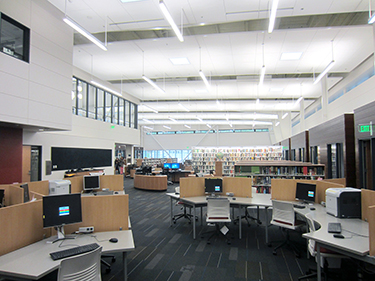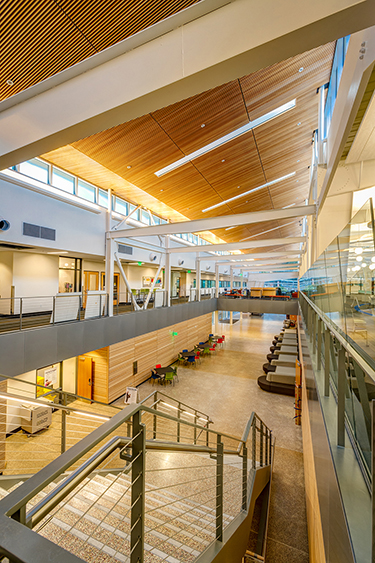|
Subscribe / Renew |
|
|
Contact Us |
|
| ► Subscribe to our Free Weekly Newsletter | |
| home | Welcome, sign in or click here to subscribe. | login |
Construction
| |
 |
August 28, 2014
How replacing an old building is like selling New Coke
SRG Partnership

Mansavage
|
The urge to innovate is real — to be creative, generate new thinking, break out of the box and sail the high seas — and preferable to getting caught in a feeding frenzy of competing interests or just paddling along in your normal circles.
Innovation in education faces these cycles regularly. The desire to do better spurs an “innovation culture,” which in architecture translates to building newer, better, cooler, more “state of the art” facilities. Tear down the old, start over with new ground-up facilities that look to the future.
However, innovation rarely starts with a blank slate, so there are some business axioms that challenge the innovation culture.
According to bestselling marketing expert Sergio Zyman many companies rely too heavily on innovation to solve their problems. Whenever a brand or business gets old and tired, the impulse is to scrap it and start over with something fresh. It sounds great, but more often than not, innovation simply doesn’t work. Zyman knows this firsthand — he was the chief marketing officer at Coca-Cola during the disastrous launch of New Coke in 1985.
Perhaps equally important to being new is the concept of stability and permanence, a sense of history and connection. Zyman wrote a book for business that praises the power of renovation over innovation, recapturing the essence of a business’s existing brands, products and core competencies, and doing more of the things that made it great in the first place.
Can you have it both ways? Can you be out on the bleeding edge but also have a sense of roots? Absolutely: Treat it — don’t trash it!
Renovation and innovation are not mutually exclusive, and in higher education combining them can be essential. An existing college campus has history and culture embedded that can spark innovation by building on existing strengths.
In 2006 SRG began working with South Puget Sound Community College in Olympia to revamp its campus master plan. At the heart of reinventing the college’s future was figuring out what to do with a 1970s-era metal shed, Building 22.
Known as the Center for Student Success, Building 22 was the largest structure on campus, set in the middle of others that had grown up around it over the years. Completed in 1976, it was the first and only permanent building on campus, below-average condition, and still used primarily for the automotive and welding programs on which the college was founded.
Building 22 has housed many functions during its life and been through a number of renovations, repairs and expansions. It was a tired old dog.
Redevelopment plans
The 2007 campus master plan identified a comprehensive list of planning recommendations that was based on the institution’s core strengths and determined a scope of work known as The Campus Center Redevelopment:
• Reorganize programs in Building 22 to provide a student- and community-centered core of student, library and information services as the physical and intellectual heart of the campus.
• Relocate automotive and welding programs to create more pedestrian-friendly uses at the campus core and provide new, up-to-date instructional spaces for these programs.
• Relocate shipping and receiving to new space at the perimeter of campus to improve safety and minimize pedestrian conflicts with automobiles and service vehicles.
The Campus Center redevelopment project became a series of projects over four phases:
• Phase 1: New Building 16 — Automotive, Welding & Central Services: Completed in 2009, this was a new building to house automotive and welding programs, as well as the main campus’ shipping and receiving. These functions vacated Building 22 prior to its renovation in phase 3.
• Phase 2: New Building 23 — Anthropology, CADD and Geomatics: Completed in 2010, this administrative and instructional building relocated various existing campus functions from Building 22 prior to its renovation in phase 3.
• Phase 3: Renovation of Building 22 — Center for Student Success: Completed and occupied in January 2014.
• Phase 4: Minor renovation of interior spaces of Building 25 — Administration: Reconfigures the floor plan after student services spaces are relocated to Building 22 during phase 3 and consolidates remaining administrative functions.
A new hub
In the fall of 2008, the college developed a learning plan for the new Building 22 program, which focused on library, student services and e-learning. Produced through a series of four all-day work sessions with the planning team, the plan highlighted and synthesized the strengths of the existing institution and made a set of recommendations.
Building 22 is now alive with the buzz of students all the time. Representing what the college has become since the 1970s, it realizes the new master plan with program uses (library, media and student services) that touch all disciplines and functions. What began as the automotive and welding facility at the center of a vocational institute has been transformed into a light-filled place promoting student interaction on the campus of a modern, comprehensive college.
The renovation and redevelopment of Building 22 has truly reinvigorated the core of South Puget Sound Community College.
Located at the physical center of campus, it is now the heart of college activities, housing functions that touch all students and faculty, and improving cross-campus circulation between adjacent buildings. Building 22 is the first place of contact for entering students and visitors, and a place for returning students to use throughout their educational experience.
A few themes from the learning-plan recommendations drove the site development:
• Campus front door: This building and its functions are part of the first impression made by the campus and represent a welcoming and responsive environment.
• Central hub: All parts of the campus will interact with this building due to its central location and functions. It has many “fronts.” Particular attention is given to the improved exterior connections to the student union and administration buildings. Exterior areas are provided with excellent lighting, clear pathways, and a variety of site seating and outdoor gathering options.
• Connection to the outdoors: The school’s beautiful, forested environment was treated with the utmost respect, with priority given to maintaining existing mature trees. Re-imagined exterior spaces around Building 22 are primarily pedestrian friendly, and to the south they engage with Percival Creek, one of the most unique and special site features on campus. To date, no other building or space on campus has acknowledged Percival Creek in this way.
Pedestrian friendly
Renovating Building 22 has redefined its ground plane, both inside and out, and made the Center for Student Success a first-floor building and place for pedestrians. Formerly, level one was a series of service entries, primarily for automotive and welding program vehicles, while pedestrians entered at level two via bridges and ramps.
At the ground level, pedestrians had mostly experienced the “backside” of Building 22. The redevelopment project removed the existing bridges and ramps, located the main entry on the first floor and introduced a series of additional entry points. Building 22 now has many “front sides” that are clear and welcoming.
The renovation and redevelopment of the Center for Student Success transformed an industrial metal shed into a new campus heart that is filled with high-quality spaces appropriate for an institution of higher learning.
Building 22’s renovation has located all program spaces along a new central commons, which serves as both an internal public space and a primary circulation street, connecting multiple building entry points with all the program components. The commons exists on two levels and provides both physical and visual connections between each program component and outward connections to the rest of the campus.
Building 22’s renovation has not provided new campus services, but rather reorganized them so that they can be delivered in a new manner, one that meets the goal for treating students in a welcoming and responsive way.
The Center for Student Success is now a one-stop shop, easily located at the heart of the campus. Transforming a physical structure and a service-delivery model gave an existing building an entirely new lease on life.
Renovation? That’s innovation.
Barney is a principal at SRG Partnership dedicated to excellence in planning and design that inspires learning.
Other Stories:
- Can you design a school theater that pleases everyone?
- What schools can learn from Starbucks
- Renton preschool offers kids a running start
- Locals designers help rebuild schools in Haiti damaged by earthquake
- What to consider when building a new school next to the old one
- WSU technology lab combines work with show
- Do art and science mix? Lab designers give it a try



_web.jpg)

_web.jpg)
